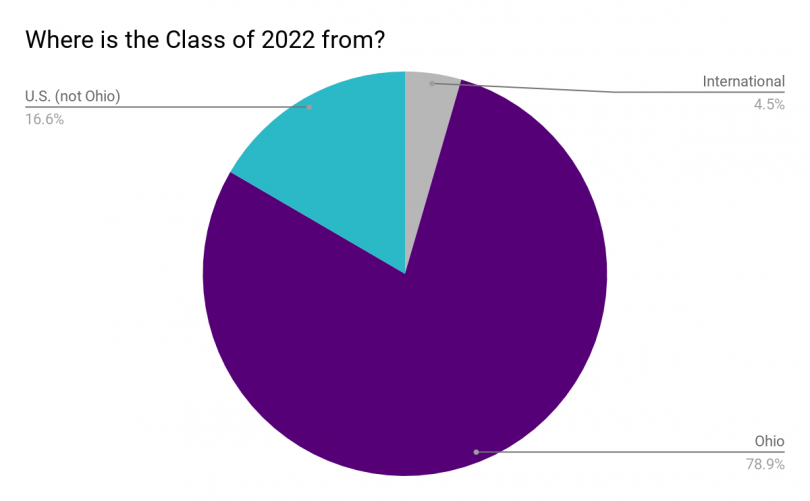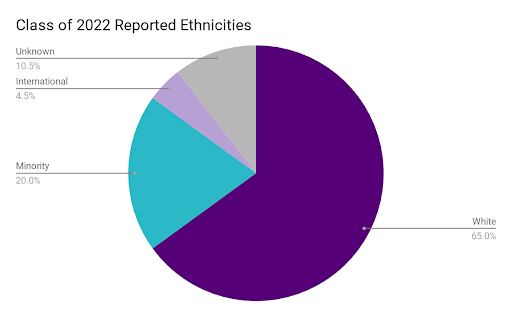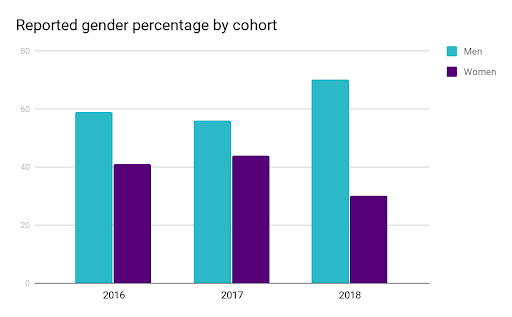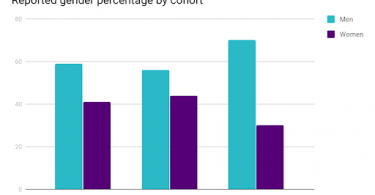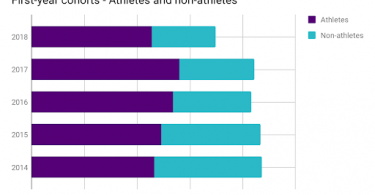The Class of 2022 arrived on campus in August, eager to be begin their college journeys as Bluffton Beavers. On Monday, Sept. 10, the official headcount for this year’s first-year cohort was finalized. While the data shows a smaller-than-average incoming class, the Class of 2022 could prove to be one of Bluffton’s most diverse.
According to data provided by Registrar Iris Neufeld, this year’s first-year cohort includes 174 full-time, first-time first-year students, compared to 211 students beginning last fall and 208 in the fall of 2016.
“Our first-year cohort is smaller than we had hoped, but the class is very strong and includes one of our largest groups of international students in recent years,” said Robin Bowlus, interim vice president of enrollment management. “The class includes five valedictorians and 13 National Merit Scholars and/or Student Council members. Thirty-three percent are ranked in the top quarter of their graduating class. We are excited to have all of our first-year students join our campus community.”
At 174 students, the cohort is Bluffton’s first incoming class since 1998 to have fewer than 200 students. The largest first-year cohort on record was 272 students in the fall of 2008.
Dean of Students Julie DeGraw said she sees the drop in first-year enrollment as part of a statewide “demographic reality.”
“Right now, we’re in a big dip in the state of Ohio with the number of high school graduates, so that’s going to continue to go down for the next five years,” said DeGraw. “We know that already, because it’s been going down for the past five years.”
Despite smaller-than-average enrollment numbers, DeGraw said the class of 2022 shows a promising increase in areas of diversity.
Neufeld’s data showed 20 percent of students beginning this fall identified themselves as minority or underrepresented students.
Numbers for international students are also on the rise. Eight students in the first-year cohort, or 4.5 percent, are international students, coming from Albania, Botswana, Honduras, Nepal and Rwanda.
Neufeld said international students are not traditionally figured into the data on minority students. When factored together, DeGraw said international and minority students comprise nearly 25 percent of the first-year class.
“We’re really excited about that. We’re also retaining underrepresented students at the highest levels we have in the last few years,” said DeGraw. “[Diversity] brings a great learning opportunity for everyone on campus.”
Neufeld’s data showed 65 percent of first-year students identified themselves as white, but she said the data on ethnicity is not entirely complete.
“Students are not required to submit ethnicity, so we do have a number of unknowns,” said Neufeld.
Out of the 166 students in the first-year cohort from the United States, Neufeld’s data listed 137 students from Ohio. The remaining 29 students are from states including Florida, Indiana, Michigan, New Jersey and Pennsylvania.
Data on Bluffton’s class of 2022 also reveals a large disparity in the percentage of men and women enrolled as first-year students. Despite research from the U.S. Department of Education indicating women are earning more college degrees than men nationally, men comprise 70 percent of this year’s incoming class at Bluffton. Out of 174 first-year students, only 53 are women.
Comparatively, Neufeld said the cohort beginning in the fall of 2017 was 56 percent men and 44 percent women. In the fall of 2016, 59 percent of first-years were men and 41 percent were women.
DeGraw said Bluffton has had more male students than female for many years. She said this is partially attributed over time to having a large population of football players, but this year’s disparity is not necessarily related to athletics.
In terms of athletics, however, 65.5 percent of the class of 2022 will compete for Bluffton’s athletic teams. Last year, the first-year cohort was 66.3 percent athletes. In the past five years, the percentage of first-year student athletes has seen an increase. For comparison, the first-year class beginning in 2014 was 53.2 percent athletes.
“We have to remember with first-year classes, the percentages are always the highest,” said DeGraw on the overall set of data on this year’s cohort. “For better or for worse with retention, things always change up a little over time.”
Bowlus said, “Under Dr. Wood’s leadership, we will make significant shifts in our enrollment strategies for the year ahead.”
As work is underway to recruit Bluffton’s class of 2023 and beyond, Bowlus said changes such as moving the Campus Welcome Center to Houshower House are part of strategies designed to increase enrollment numbers by creating a unique visit experience that introduces prospective students and families to Bluffton’s value of community the minute they arrive on campus.


